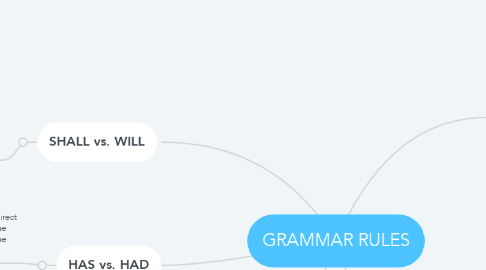
1. SHALL vs. WILL
1.1. Shall was used when the subject was in the first person and will in other cases.
2. HAS vs. HAD
2.1. ''Has'' is a transitive verb, it requires a direct subject and one or more objects. It is the third person singular present tense of the verb ''have".
2.2. ''Had'' is the past tense of the transitive verb "has". Its is the third person singular past tenses and past participle of the verb ''have''.
3. WAS vs. WERE
3.1. "Was'' is used in the first person singular (I) and the third person singular (he, she, it).
3.2. ''Were'' is used in the second person singular and plural (you, your, yours) and first and third person plural (we, they).
4. THAT
4.1. Use "that" as a structural device to aid understanding. Structural "that"
4.1.1. e.g. "The people alleged that defendant committed murder."
4.2. Nonstructural "that"
4.2.1. e.g. "The point that he made is not to be wordy." Becomes: "The point he made is not to be wordy."
4.3. Discoursive "that". Use "that" to distinguish discourse.
4.3.1. e.g. Direct Discourse: " The senior partner said, 'Bill researched the issues.'" Indirect Discourse: "The senior partner said that Bill researched the issues."
4.4. Extra "that". Avoid losing parallel structure by adding an unnecessary "that" ins a string of clauses.
4.4.1. e.g. ''The legal-writing teacher said that that 'that', that 'that' that that 'that' referred to, is a triply vague referent." (Written differently, "Said the legal-writing teacher: 'The "that", which is the "that" to which the "that" refers, is a triply vague referent."
4.5. Double "that".
4.5.1. e.g. "That that" becomes "that this" or "that the."
5. WHICH
5.1. Modifying "which". Keep modifiers next to the words and thoughts they modify.
5.1.1. e.g. "Family Court rendered judgment for respondent which the Second Department reversed." Becomes: "Family Court rendered for respondent a judgment that the Second Department reversed."
5.2. Hard-working "which". Don't make your "whiches" work too hard. The antecedent c]becomes vague as the relative becomes remote.
5.2.1. e.g. "Respondent stared wildly around the courtroom, which was noticeable to everyone." Becomes: "Respondent stared wildly around courtroom. Everyone notices his wild stares."
5.3. Elegant "which". Use elegant "which" to replace the second "that".
5.3.1. e.g. "This is the format the associate uses and which the client adopted."
5.4. Appositive "which". Excise your "which" after an appositive.
5.4.1. "This opinion, which was written for publication, is a masterpiece," Becomes: "This opinion, written for publication, is a masterpiece."
5.5. Legal "which". Withdraw your legal "whiches".
5.5.1. "The parties entered into a contract in March 1955, which contract is binding." Becomes: "The parties entered into a binding contract in March 1955."
